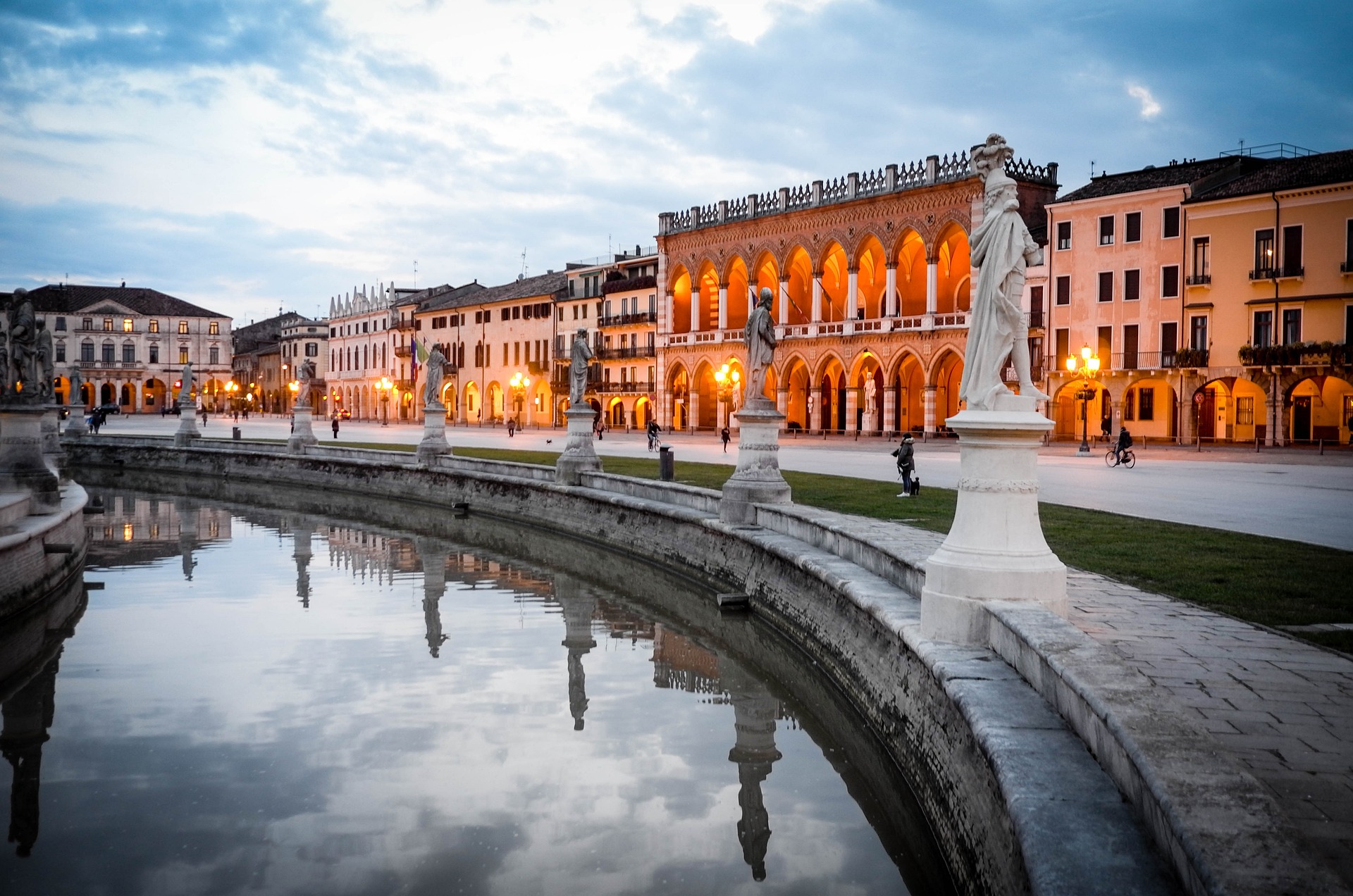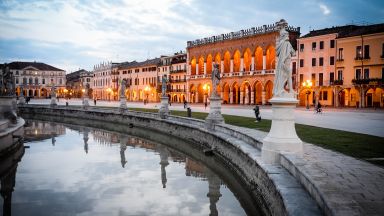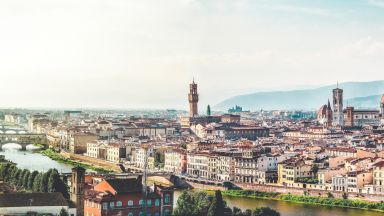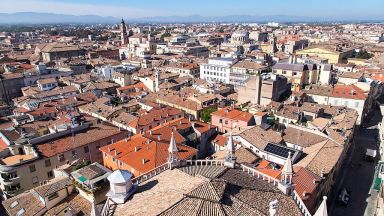Self-Guided Walking Tour of Padua (with Maps!)
This website uses affiliate links which earn a small commission at no additional cost to you.
Padua is a city in the Veneto region in the northeast of Italy and is home to the second oldest university in Italy (the oldest is in Bologna). This, plus the historical wealth of the city, has created a legacy of grand buildings, many filled with the medieval frescoes for which Padua is famous. There is an Italian popular saying: “Venice is beautiful, Padua is her sister”.
It has two UNESCO’s World Heritage Site list. Once for its 14th-century frescoes and another for its Orto Botanico – the oldest academic botanical garden in the world!
It is also an important place of pilgrimage: St Anthony is buried in Padua and the 25 km Walk of Saint Anthony ends here. Then there is the Shakespeare connection: this was the setting for his play Taming of the Shrew. As you walk the shady colonnaded streets you can imagine yourself back in that world, in the place that Petruchio describes as “fair Padua, nursery of the arts”.
How to get to Padua?
By Car: Padova is strategically located at the crossroads of major motorways in Italy. For those traveling from the west (Venice) to the east (Milan), you can access the A4 motorway (Venice-Milan) and take the Padova Est exit if you are coming from Venice or the Padova Ovest exit if you are arriving from Milan. If your journey brings you from the south (Bologna) to Padova, you’ll be on the A13 motorway (Bologna-Padova). Take the Padova Sud exit, and from there, you can follow the signs guiding you to the center of Padova or continue in the direction of the A4 motorway (Milan-Venice) if you wish to travel east.
Warning: The centre of Padova is a Traffic-Restricted Area (ZTL).
Parking: The most convenient parking is Piazza Rabin, just to the south of Prato della Valle – about € 1.50 an hour. From here head north through the arch to arrive at Prato della Valle.
By Train:
Padua is easy to reach by train from many other nearby Italian cities. All the trains that move between Milan-Venice and Bologna-Venice stop in Padua. To get to the centre from the train station walk down Corso del Popolo.
Prato della Valle
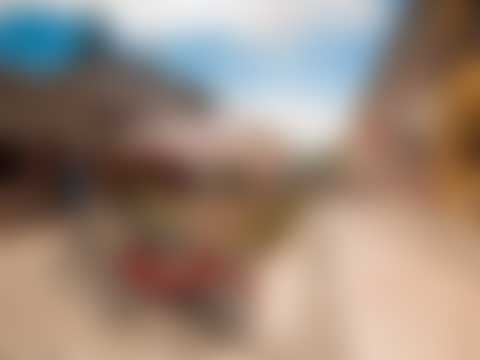
Prato della Valle, Italy’s largest square, stands as one of Padua’s most iconic attractions. Covering an expansive area of 90,000 square meters, it boasts an elliptical shape. The square is bordered by a canal that encircles an oval space known as the Isola Memmia, named after Andrea Memmo, the visionary behind Prato della Valle in the 18th century.
Two concentric rings of statues grace the perimeter of the canal, totaling 78 in all, each representing prominent figures intertwined with the rich history and culture of Padua. For instance, statue number 36 pays homage to Galileo Galilei, who famously declared that he “spent the happiest 18 years of his life living and teaching in Padua.” Statue number 35 commemorates the renowned humanist and poet Petrarch, who was a frequent visitor to Padua in the 14th century. Statue number 21 immortalizes the illustrious Renaissance artist Andrea Mantegna, who both studied and worked in Padua. Notably, pinpoint 12 on this list leads to the opportunity to view Mantegna’s renowned cycle of frescoes in the Church of the Eremitani in Padua.
Prato della Valle serves as a vibrant hub for many of Padua’s major events and festivals. It regularly hosts bustling markets, featuring an array of fresh produce, vintage items, and assorted treasures.
Take a moment to explore Prato della Valle, and you’ll discover a treasure trove of picturesque opportunities. The stately Lodge Amulea and the imposing structure of the Basilica of Santa Giustina present splendid subjects for your photography. Be sure to capture the beauty of these landmarks with your camera to preserve the memories of your visit.
Location: Prato della Valle, Prato della Valle, Padua, Province of Padua, Italy | Hours: 24 Hours | Price: Free
Read more about Prato della Valle
Orto Botanico

Walk straight through the oval park, then walk anti-clockwise around it before turning onto Via Beato Luca Belludi. Quickly turn off to the right to walk down the pedestrianised Via Donatello, after 200m you arrive at the University of Padua Botanical Gardens.
Padua’s Botanical Garden holds the distinction of being the world’s oldest University Botanical Garden that remains in its original location. Established in 1545 under the patronage of the Venetian Republic, its primary purpose was to assist students at Padua University in their studies of pharmacology and medicinal plants.
Today, this garden is a UNESCO World Heritage Site, home to a remarkable collection of over 7,000 botanical species. Among its remarkable inhabitants is a palm tree that has graced the garden for more than four centuries. It’s worth noting that Goethe’s “Essay on the Metamorphosis of Plants” was inspired during his visit to Padua University Botanical Garden. Here, he encountered the age-old palm tree, dedicating time to its observation and study.
The botanical garden is divided into two distinct sections:
Historical Garden: This segment represents the original garden as it was conceived in 1545. Its layout takes the form of a circular shape, symbolizing the world, enclosing a square that is further divided into four smaller squares. The garden features strategically placed fountains and water features, making it a delightful spot to explore, even on warm summer days. Encircling the Historical Garden is a towering circular wall, erected centuries ago to deter theft of valuable medicinal plants.
Biodiversity Garden: Inaugurated in September 2014, this modern addition to Padua University Botanical Garden is housed within a contemporary glass structure. A visit to this garden provides a journey through various global climate zones, from the most arid to the lushest, allowing visitors to admire plant life indigenous to each region.
Padua University Botanical Garden has played a pivotal role in the advancement of botany and pharmacology. It was instrumental in introducing several economically significant plants, such as sunflowers and potatoes, to Italy. Prospero Alpini, the garden’s director in the early 17th century, was the first European to provide a comprehensive description of the coffee plant and its medicinal properties. This garden stands as a testament to the invaluable contributions of botany and botanical research to science and society.
Visitng Orto Botanico: November – March 10am-5pm. April – September 10am-7pm. Adults €10 https://www.ortobotanicopd.it/en/tickets-and-subscriptions
Location: Orto botanico dell'Università degli Studi di Padova, Via Orto Botanico, Padua, Province of Padua, Italy | Hours: 9am-7pm Tue-Sun Apr-Sep, to 6pm Oct, to 5pm Nov-Mar | Price: adult/reduced €10/8, with PadovaCard €5 | Website
Read more about Orto Botanico
Piazza del Santo & Equestrian Statue of Gattamelata

Head back to the entrance of the gardens. After crossing the small bridge, turn off Via Donatello and walk up Via Orto Botanico until you reach the Piazza del Santo.
One of the main reasons for visiting the Piazza del Santo is it see the Equestrian Statue of Gattamelata. It is one of the most famous statues in Italy, made by Donatello in 1446, it represents Erasmo da Narni, who was a soldier fighting for the church and for the Venetian Republic. His nickname was Gattamelata. It was the first equestrian statue of this size since antiquity and was commissioned by the soldier’s wife and son. The house in which Donatello lived during his time in Padua is located opposite the Basilica.
Location: Piazza del Santo, Padua, Province of Padua, Italy | Hours: 24 Hours | Price: Free
Read more about Piazza del Santo
Basilica of Sant’Antonio

Padua is affectionately known as the City of the Saint due to the deep and heartfelt devotion of its locals to St. Anthony. The term “Il Santo” is used by the citizens of Padua to refer both to the Saint himself and to the exquisite basilica that enshrines his relics.
Originally constructed between 1232 and 1310, with subsequent modifications over the centuries, the Basilica of St. Anthony stands as Padua’s most significant religious landmark. Annually, it welcomes five million pilgrims. This basilica is a must-visit, showcasing a harmonious blend of architectural styles, magnificent frescoes, numerous chapels holding precious relics, and a wealth of masterpieces.
Key highlights within the basilica include:
- Chapel of St. Anthony: A splendid Renaissance masterpiece where visitors come to offer their prayers before the Saint’s tomb.
- Chapel of the Relics (Treasury Chapel): Here, you can behold the Incorrupt Tongue of St. Anthony, along with numerous other revered relics. The meticulous craftsmanship and artistry evident in the design and creation of the reliquaries, chalices, and religious artifacts preserved here are truly breathtaking.
- Presbytery and Main Altar: This area is a magnificently frescoed and ornamented space, adorned with 15th-century statues and bas-reliefs by the renowned artist Donatello. These are among the most prized artistic treasures within the Basilica.
- Cloisters: These cloisters are not only beautifully maintained but also house fragments of preserved frescoes, providing a glimpse into the basilica’s rich history.
- Museums of the Basilica: These museums offer an opportunity to delve deeper into the life and work of St. Anthony and to admire a collection of artworks owned by the Basilica.
- Oratory of St. George and School of the Saint: Two small buildings adjacent to the main body of the Basilica. The first hosts one of the most precious 14th-century fresco cycles. The second features a series of frescoes by Titian and other renowned local painters.
Information for Visiting Anthonian Museum, Oratory of St George & Little School: Open Tuesday to Sunday 9.00 to 13.00 and 14.00 to 18.00, Adult Ticket €7 https://www.santantonio.org/en/content/times-and-single-ticket-various-museums-shrine
Location: Basilica di Sant'Antonio di Padova, Piazza del Santo, Padua, Province of Padua, Italy | Hours: 6.20am-6.45pm Mon-Sat, to 7.45pm Sun | Website
Read more about Basilica di Sant'Antonio
MUSME - Museum of the History of Medicine

From the square head away from the Equestrian statue of Gattamelata up the Via del Santo. At the end when you reach Via S. Francesco turn right to see the MUSME – Museo di Storia della or left to see the MUSME – Museo di Storia della or right to reach the Palazzo Bo.
MUSME is a collection of exhibits that describe the history of medicine. Since the University of Padua houses one of the oldest medical schools in the world, it is fitting for this museum to be located in the historic center of Padua, within walking distance of the medical school. Exhibits explain gross anatomy, the development of pharmacology, surgery and also focus on the evolution of medical education.
Location: MUSME, Via San Francesco, Padua, Province of Padua, Italy | Hours: 2.30-7pm Tue-Fri, 9.30am-7pm Sat & Sun | Price: adult/reduced/child €10/8/6 | Website
Read more about MUSME - Museum of the History of Medicine
Palazzo Bo

Come out of the building and turn right onto Via S. Francesco. You will pass Piazza Antenore which has the Tomb of Anthenor. This is a historical medieval tomb, falsely attributed to the mythical founder of Padua, more probably the remains of a Hungarian warrior and not the Trio prince.
Opposite this is the Palazzo Romanin Jacur. A 14century palace that Dante lived in Padua during his exile.
At the end of the piazza is the location of the Ponte San Lorenzo, the remains of a segmental stone bridge with 3 arches, built by the Romans from 47—30 BCE. Unfortunately now inaccessible and not visible from the street.
At the next block turn north onto Via VIII Febbraio to reach Palazzo Bo.
Take a guided tour of the University of Padova, one of the oldest in Europe, where Galileo taught for a dozen years, and which awarded the first Ph.D. in the world to a woman in the 17th century). It is a fabulous renaissance building and tiered courtyard that housed the main campus of the University of Padua’s medical school for centuries. As such, it is decorated to the hilt with the family crests of all the illustrious teachers and alumni who have walked these old stone floors.
Look out for the lectern where Galileo taught!
Location: Palazzo Bo, Via VIII Febbraio, Padua, Province of Padua, Italy | Hours: Main courtyard Free See website for 45-minute guided tour | Price: adult/reduced €7/4 | Website
Read more about Palazzo Bo
Cafe Pedrocchi

Carry on north on Via VIII Febbraio to reach Piazzetta Cappellato Pedrocchi, or to skip it take first left to go straight up Via Guglielmo Oberdan another bloack to see Pedrocchi Café.
Walk past the historic Pedrocchi Café. Known for its part in the 1848 riots against the Habsburg monarchy, as well as for being an attraction for artists over the last century from the French novelist Stendhal to Lord Byron to the Italian writer Dario Fo. Pricing is as you would expect for a historic building.
Location: Caffè Pedrocchi, Via VIII Febbraio, Padua, Province of Padua, Italy | Hours: 8.00am to Middnight | Website
Read more about Cafe Pedrocchi
The Roman Arena and the Arena Gardens

Head north out of Piazza Cavour, one of the main squares, dedicated to Camillo Benso, Count of Cavour, one of the most important Italian politic leaders at the time of of early Italian independence wars and first Prime Ministero of Italian Kingdom in 19th century. Continue past Piazza Garibaldi, leaving it to walk along Corso Guiseppe Garibaldi. You will see the Roman Arena on your right and the The Palazzo Zuckermann Museum on your left.
The Roman Arena of Padua was an amphitheatre used for gladiator games in the ancient Patavium. The Arena ruins are now part of the Giardini dell’Arena park. Today, only a few ruins remain part of the bearing walls and a series of arches. The remains of the Arena have recently undergone a cleaning and restoration process. In parallel, an excavation project is also underway to bring to light the original structures of the Arena, floors and foundations, buried over the centuries by numerous stratifications and subsequent building works.
Location: Arena Romana di Padova, Piazza Eremitani, Padua, Province of Padua, Italy
Read more about Roman Arena of Padua
Palazzo Zuckermann

The palazzo is home to the Museum of Applied and Decorative Arts, with over two thousand exhibits that might be called the hidden patrimony of the Padua City Museums. It also houses the Museo Bottacin, which has a rich collection of medals and coins. The neoclassical facade of the building has elements influenced by the Liberty style – the Italian version of Art Nouveau.
Location: Palazzo Zuckermann, Corso Giuseppe Garibaldi, Padua, Province of Padua, Italy | Hours: 10am-7pm Tue-Sun | Price: adult/reduced €10/8
Read more about Palazzo Zuckermann, Padua
Chiesa degli Eremitani

The Church of the Eremitani (Chiesa degli Eremitani) is a 13th-century Gothic-style church known for its rich collection of artworks. Tragically, during the Second World War, the church suffered damage when it was mistakenly bombed by the Allied Forces. It is said that the proximity of the German headquarters in Padua to the church led to this unfortunate incident. Despite being on the ‘do not bomb’ list of cultural heritage sites, it became a casualty of war.
The most severe damage was inflicted on the church’s Ovetari Chapel, which had been adorned with frescoes by a group of renowned Renaissance artists in the 15th century. Among these artists, Andrea Mantegna’s name shines brightly. Mantegna had a unique approach to painting, which resembled the work of a sculptor wielding a paintbrush. His skill in depicting finely sculpted bodies, expressive faces, and intricate architectural backgrounds has garnered admiration for centuries. Many of his paintings now grace famous museums and galleries worldwide.
When the bombs struck the Church of the Eremitani on March 11, 1944, Mantegna’s frescoes crumbled into a staggering 88,000 fragments. This incident represented Italy’s most devastating art loss during the war. Only many decades later, thanks to advanced software, were the frescoes meticulously reconstructed, resembling a massive jigsaw puzzle with numerous missing pieces. Observing the restored frescoes in person brings to light the truly devastating impact of war on cultural treasures.
Location: Chiesa degli Eremitani, Piazza Eremitani, Padua, Province of Padua, Italy
Read more about Chiesa degli Eremitani
Musei Civici di Padova

Walk anti clockwise around the arena and you will come to the Musei Civici di Padova.
Part of the Eremitani Civic Museums complex, the palazzo houses the Museum of Applied and Decorative Arts and the Bottacin Museum in its rooms. The museum complex is headquartered in Piazza Eremitani, in the cloisters of the former Augustinian monastery adjacent to the Church of the Eremitani. But the Eremitani Civic Museums encompasses a series of monumental sites and various museums located in different buildings in Padua, showcasing an expansive collection ranging from archaeological objects to medieval and modern art.
Location: Musei Civici Eremitani, Piazza Eremitani, Padua, Province of Padua, Italy | Hours: 9am-7pm Tue-Sun | Price: adult/reduced €10/8
Read more about Musei Civici di Padova
Cappella degli Scrovegni

Cone out of the Musei Civici di Padova and turn left you will see the Cappella degli Scrovegni backing onto the Roman Arena.
The Scrovegni Chapel, located in Padua, was adorned with an array of magnificent frescoes by the renowned artist Giotto in the early years of the 14th century. This remarkable transformation of the chapel was commissioned by the local moneylender, Enrico Scrovegni.
Giotto’s position as one of the most significant painters in history is indisputable, as he played a pivotal role in redefining the boundaries of pictorial expression. His influence on the art world is immeasurable, casting a long and enduring shadow across the annals of art history. To discuss the history of art without acknowledging the profound impact and enduring legacy of Giotto would be incomplete.
Among Giotto’s many masterpieces, the fresco cycle in Padua’s Scrovegni Chapel stands as his crowning achievement. This breathtaking work of art is a testament to his unparalleled talent and artistic vision, and it remains a cherished treasure for all who have the privilege of experiencing it.
Location: Cappella degli Scrovegni, Piazza Eremitani, Padua, Province of Padua, Italy | Hours: 9am-7pm, night ticket 7-10pm | Price: adult/reduced €13/8, night ticket €8/6
Read more about Cappella degli Scrovegni
Ponte Molino

Cross back over Corso Guiseppe Garibaldi and walk along Via Giotto. Turn third left down Via del Carmine and when you get to the end turn left to get to Ponte Molino.
Ponte Molino is an ancient Roman bridge featuring five graceful arches. Its construction dates back to the years 30-40 AD, and it offers enchanting vistas of the Bacchiglione River. This bridge is among the few surviving Roman bridges in Padua and a rare example of an ancient bridge designed for the passage of both pedestrians and vehicles.
The bridge earned its current name, “Molino,” due to the presence of floating watermills operating adjacent to it from the 10th century until the late 19th century.
The road that traverses this bridge was historically Padua’s most important street, known as “Stra’ Maggiore.” It was watched over by the Torre di Ezzelino, an imposing tower constructed by a famous medieval tyrant. While the tower can still be seen at the far end of the bridge, your attention may also be captivated by another significant structure that stands beside Ponte Molino – the renowned Porta Molino.
Porta Molino, a substantial gate, was erected in the 13th century and formerly served as the most critical gate in Padua’s medieval defensive walls. Local legend has it that the gate’s height was such that Galileo Galilei used it as an observatory for his celestial observations.
Location: Ponte Molino, Via Dante Alighieri, Padua, Province of Padua, Italy | Hours: 24 Hours | Price: Free
Read more about Ponte Molino
Piazza dei Signori & Torre dell'Orologio

Walk across Ponte Molino and down Via Dante Alighieri. When you reach Piazza dei Signori you will see the Torre dell’Orologio on your right.
The Torre dell’Orologio is a clock tower situated in Piazza Dei Signori, nestled between the Palazzo del Capitanio and the Palazzo dei Camerlenghi in Padua, Italy. It is also known as the astronomical clock of Padua. The tower’s construction commenced in 1426 and was completed around 1430. The tower was commissioned by Prince Ubertino de Carrara, a member of the Carrara clan in Padua, who served as the Lord of Padua from 1338 to 1345. Subsequently, it was expanded to accommodate the new clock, which was crafted in 1427. The clock itself was finished in 1434. In 1436, decorative elements were added to the clock’s dial, and a year later, the clock tower was inaugurated. At the tower’s base, the grand triumphal arch, designed by Giovanni Maria Falconetto, was incorporated in 1531.
The clock’s design and construction were overseen by Giovanni Dondi dell’Orologio, also known as Giovanni de’ Dondi, an Italian physician, astronomer, and mechanical engineer. Gian Petro Dalle Caldiere provided assistance during the process. The clock’s design features references to the zodiac. However, the original clock did not include the Libra sign, as in the pre-Roman system, Scorpio and Libra were considered one zodiac sign.
The clock’s dial portrays the Earth at its centre, displaying the phases of the Moon, days, months, and the zodiac signs. Today, the clock is accessible to the public, with a group of volunteers known as Salvalarte ensuring that such sites remain open for public enjoyment. This group is affiliated with a nationwide environmental association.
Location: Torre dell'Orologio, Piazza dei Signori, Padua, Province of Padua, Italy
Read more about Torre dell'Orologio, Padua
Duomo di Padova

Walk past the Torre dell’Orologio along Via Monte di Pietà until you reach the Piazza Duomo.
Although the interior of the Duomo is quite simple, it is worth to visit this beautiful renaissance style church. There is separate entry to the baptistry so you do not need to go in via the cathedral, which costs 3 euros. The 12 century baptistry of the Duomo contains one of the most complete medieval fresco cycles to survive in Italy.
Location: Padua Cathedral, Piazza Duomo, Padua, Province of Padua, Italy | Hours: 7am-noon & 4-7.30pm Mon-Fri, 7am-7pm Sat, 8.30am-8pm Sun, baptistry 10am-6pm | Price: baptistry €3
Read more about Duomo di Padova
Palazzo della Ragione

Either return to the Piazza dei Signori and walk past the Chiesa di San Clemente or walk down Via Daniele Manin to reach the Palazzo della Ragione.
It is worth visiting Palazzo Della Ragione and you should make time to go inside to see the frescoes. It is a stunning medieval town hall that was built in the 13th century. There are three floors, the underground has Roman ruins but is not always accessible to the public. Secondly, the ground floor is a wonderful place to get something to eat because it is full of cafes and then finally the top floor is where you will find the frescoes.
Head south down Via Roma to return to Prato della Valle.
Location: Palazzo della Ragione, Piazza delle Erbe, Padua, Province of Padua, Italy | Hours: 9am-7pm Tue-Sun Feb-Oct, to 6pm Nov-Jan | Price: adult/reduced €6/4
Read more about Palazzo della Ragione, Padua
This website uses affiliate links which earn a small commission at no additional cost to you.
